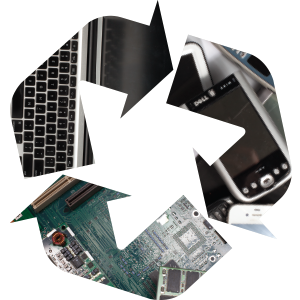The E-Waste Land

Can consumers, environmentalists and entrepreneurs reclaim pollution and turn it into profit?
Giant cardboard boxes six feet high overflow with bright green and silver server boards. Shiny flat screen TVs rest on the floor next to their clunky, decade-old counterparts. In the center of the warehouse, off-white printers, turning yellow with age, are stacked five high. All around, tight bundles of wires are clumped together like tumbleweeds.
Close to 1.2 million pounds of e-waste arrive at this collection facility each month. Some of these discarded electronics look like the things I knew as a kid—old Sega Genesis systems and green-screened Apple computers with floppy-disk drives—but some of it is nicer and newer than the stuff I own now.
“The reason e-waste is an issue is because people choose to be lazy,” says Eddie Inamdar, ’93 Computer Science, as we stroll his 13,000-square-foot e-waste collection center in Union City, located between a badminton training center and a door and window wholesaler. “Lazy, and maybe a little ignorant. When they discard a computer mouse or printer cartridge in the garbage, it goes to the landfill and stays there for 200 years. People just don’t realize the harm they are doing to the environment.”
A self-proclaimed “compassionate capitalist” and ardent environmentalist, Inamdar achieved early success in the computer industry in his late 20s. Thirteen years ago, he came out of a very young retirement to found and serve as CEO of E-Waste Recycling Center (recycle1234.com), an e-waste collection company with three locations throughout the East Bay and a fourth in the works.
“We didn’t start this business to make money,” Inamdar says. “We started it as a way to give back. But there is money in it because there’s a big need for raw material all over the world. Reclaiming raw material from e-waste has become a big industry.”
E-waste is defined loosely as any consumer or business electronic product that has reached the end of its life cycle (whether actually or perceived). The term itself is deceptive. A great deal of what is termed “e-waste” is not waste at all. Often it is product marketable for resource recovery or reuse.
Despite the efforts of Eddie Inamdar and others like him, there remains a lot of e-waste to recover.
Heavy problem
According to U.S. Environmental Protection Agency estimates, in the U.S. in 2009 there were 2.37 million short tons of electronic products ready for end-of–life management, with another five million in storage. Only 25 percent of these tons were collected for recycling. On a global scale, an estimated 50 million tons of e-waste are generated every year.
If only 25 percent is being recycled, where do the other millions of tons go?
SJSU Environmental Studies Professor Bruce Olszewski is president of the board of the Silicon Valley Toxics Coalition and also directs the Center for Development of Recycling, a university-based, non-profit, environmental research and service organization that works on environment-related projects, including recycling, for businesses, government agencies, consultants, and non-profit organizations. “We throw things away, but there’s no such thing as away,” he says. “And there’s no such thing as the recycling fairy.”
Here in California, if you toss your old phone, laptop or PlayStation into the garbage bin, it will most likely end up in a landfill. Over time, the hazardous chemicals contained in the device can leach out into the earth, potentially trickling down into the water tables. And if you put it in the recycling bin? Depending on your city, there may or may not be recovery facilities that sort through the recycling, targeting certain materials (in San José, there is), but this still presents risky hazards: items often break and spill their toxic contents. If that discarded electronic happens to be an old cathode ray tube (CRT) television monitor, you are talking about up to eleven pounds of lead bursting into a cloud of very dangerous dust.
Also to be considered: the drain on natural resources.
Explains Olszewski: “If you throw a bunch of wire in your garbage bin, it’s not going to get recycled. In fact, they’re going to have to go out and make more copper, which means they have to tear it out of more mountains and put more cyanide in the tailings to get copper to leach out. Meanwhile you just sent yours to the dump.”
In the absence of federal legislation, California enacted the Electronic Waste Recycling Act in 2003, the first state to do so. The legislation ensures a reduction of hazardous substances in certain new electronic devices and the collection of recycling fees for electronic devices with four-inch and larger screens. Those recycling fees then go to qualified e-waste collectors like Inamdar, incentivizing collection and recycling.
Although the landmark legislation has been successful in keeping large amounts of e-waste out of landfills, several categories of e-waste are not covered by the four-inch screen stipulation. Left out are printers, fax machines, fluorescent light bulbs, cell phones and VHS players. Additionally, and perhaps more significantly, the Electronic Waste Recycling Act relies on good consumer behavior. And if U.S. consumers are “lazy,” as Inamdar says, and fail to deliver e-waste to a certified collector, there’s no knowing precisely where it’s going. What we do know: a percentage of our country’s e-waste ends up overseas.
Hazardous exportation
Over the past decade, the web has been flooded with images from Africa, India and China showing an e-wasteland of discarded Western electronics, landscapes littered with cells phones, personal computers, refrigerators and air conditioners. Dirt-smudged children sit in grey puddles playing with curly, discarded telephone cords; water buffalo crunch their way over fields of flat screens.
How so much e-waste is landing on the shores of China and other developing nations is difficult to determine. The U.S. remains one of the few developed nations to decline to ratify the 15-year-old Basel Convention, an international treaty banning the export of hazardous waste to developing nations. According to the EPA, reliable data on how much e-waste is being exported from the U.S. is not available. “Getting these numbers is really, really hard,” admits Hilary Nixon, associate chair of SJSU’s Department of Urban and Regional Planning, who studies e-waste end-of-life management and “green” electronics. “It’s not like you have a shipping document saying what’s happening and where it’s going.”
Put pollution to work
Since the 1990s, Europe has been using an Extended Producer Responsibility (EPR) system for packaging materials. (As yet, there is no comparable EPR system in the U.S.) The European system is financed by licensing fees paid by manufacturers that are based on the quantity and type of materials those manufacturers use in packaging. (A reduction in material consumption results in a reduction in fees.) All licensed products are marked with a logo, called the Green Dot. When consumers see the logo, they know the product qualifies. Households are provided with special receptacles for household Green Dot waste collection, and larger waste collection receptacles are located in convenient public places, such as supermarkets. Waste is sorted and returned for recycling to the producer who created it.
“If you make it, then you take it,” explains Olszewski. The EPR approach reduces both governmental involvement in recycling and a reliance on individual recycling practices. It also “automatically creates a market,” Olszewski points out. “The reason we have piles of anything is because it doesn’t have an economic value.”
Nixon agrees. “There is something to be said for policies that put a price on pollution and use that economic, monetary trigger to signal appropriate behavior.”
By creating a domestic market for e-waste, “we can create all kinds of jobs,” Olszewski continues. “Jobs for people who collect and separate e-waste, jobs for people who process it, jobs for people who sell it, and jobs for people watching the marketplace. Create a whole new economy while reducing resource consumption and pollution. What’s not to like?”
Opportunity and incentive
Who knows the most about products? Product designers. Who is most likely to know how to reduce the toxicity of those products? Product designers.
For a university that trains the people who make things, this is encouraging news.
“I think we have an incredible opportunity here at SJSU,” says Nixon. “We are training top-notch designers and engineers who will go and work for high-tech industries.” What if part of that training encouraged students to look beyond the costs of making the product and other basics? Nixon speculates. What if those designers, inspired by the principles of “Design for the Environment,” began to “think about product design in a new, innovative way? How exciting would that be?” she asks.
Products based on “Design for the Environment” principles are built to be safer, less toxic, have a longer lifespan and less of a total environmental and human impact from cradle to grave. Its counterpart, “Design for Disassembly,” aims to create products that can be safely dissembled and the materials of those products, such as precious metals, recovered.
SJSU’s curriculum currently includes a course on green and sustainable product design, offered by the Department of Mechanical and Aerospace Engineering, and courses on recycling and resource management and hazardous waste, offered by the Department of Environmental Studies.
It’s a start, but there is room to grow.
“How are we supposed to create leaders if we don’t even have university degrees or courses in the field?” asks Olszewski.
Inamdar agrees. “It’s about opportunity and incentive,” he says. “We just need more people to know that there’s money in it; it’s good for the environment; it’s good for future generations; and it helps California.” Get that message out, and “e-waste will no longer be an issue,” Inamdar says. “I’m serious. There could be no e-waste in our landfills.”
Allison Arbuthnot Sanders is a staff writer for Washington Square. A former food writer, she enjoys telling the stories of the people and places that power SJSU.
Learn more about SJSU’s sustainability efforts—and how you can reduce your footprint.





Nice article. I’d like to follow up sometime to discuss this further. I am especially interested in the role of incentives in encouraging recycling.
Thanks for the comment, Ramesh. Send us an email at wsqeditor@sjsu.edu to continue the discussion.